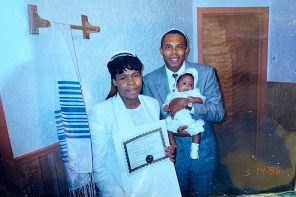Amen, Amen, Amen: Memoir of a Girl Who Couldn’t Stop Praying (Among Other Things)
by Abby Sher
(Simon & Schuster, October 20, 2009)
How does an eleven-year-old girl cope with the trauma of losing both her favorite aunt and her beloved father in the span of one calendar year? She may pray to God daily to ask Him to protect her loved ones.
But what happens when prayer becomes more than just a comfort? What happens when it becomes a compulsion? This question is at the heart of Abby Sher’s memoir Amen, Amen, Amen: Memoir of a Girl Who Couldn’t Stop Praying (Among Other Things).
The power of prayer has been the subject of much debate and research, with studies claiming that prayer can help heal the sick, even when the sick person has no relation to the people offering the curative incantation, or that person doesn’t know that he or she is being prayed for. There are other studies that show people who pray experience feelings of relief: it makes sense that prayer could benefit those for whom religion is personally significant. If it’s good for people, even if it’s not provably efficacious, what’s the harm?
Bizarre or Faithful?
Abby Sher’s compulsions began when she was a small child—from tearing up paper napkins at the dinner table to tracing the wallpaper on her bedroom walls until her finger bruised. The impulses grew more invasive as Sher grew older and calamity became a fixture in her life. An emotionally fragile, pre-adolescent Abby identified herself as the one to blame for the unexpected deaths in her family, and turned to God for help. But her sense of consolation was quickly overshadowed by a consuming fear of causing death and danger. Abby became convinced that giving herself fully to God and doing His protective bidding was the only way to ensure that no one else would meet an untimely, tragic fate.
For all the benefits that prayer might offer, it does not offer safety from disaster. When an ambulance passes, the repeated mumbling of a self-created supplication like “I hope you get there in time” fifty times won’t guarantee anything. But Abby was certain the lives of others were her responsibility and hinged on her pact with God. She imagined in vivid detail the terrible deaths that were a result of her betrayal of God’s love—betrayals as benign as kissing a boy (proving that her affections and desires were not entirely sacred). To Abby, the balance of the world rested squarely on her shoulders, and the slightest misstep on her part set in motion scenarios with disastrous consequences.
No doubt this manner of irrational thinking will sound strange to most people, religious or not, and Sher does a good job of allowing the reader an insider’s view of the logic behind her delusions. Much of her behavior fell within the bounds of the normal, especially in a devoutly Jewish context. On the surface, Abby appeared to be a staunch, if somewhat peculiar, follower of God. It is only when we learn what was going on in her head that Sher’s actions read as bizarre instead of faithful.
Ascetics throughout history have gotten into trouble for exhibiting behaviors far more extreme than Sher’s; the difference between mystical devotion and mental illness can be hard to construe. It is primarily though a lens of psychoanalysis that compulsive ritual begins to be regarded as illegitimate or destructive. In Sher’s case, even when she began seeing a therapist, her faith served to reinforce some of her more ritualistic actions, like daily fasting—a behavior that, when decontextualized, was revealed as severe anorexia.
From OCD to Atheist
While some of Sher’s obsessive behaviors would come and go (such as collecting thumbtacks, candy wrappers, and paper clips from the ground then meticulously hoarding the pile of “life-threatening trash” in a dresser drawer for months), it was the religiously-rooted habits that persisted.
To me, this continuity makes sense. When religious teachings tell us that we have a greater purpose in life, a calling to which we are meant to give ourselves wholly, we can use these beliefs to justify almost anything. Sher’s compulsions were not arbitrary, they were created from pieces of information she gleaned from religious teachings as well as from the world around her: trash can be perilous; loving God is pure and good; God will ruthlessly punish sinners. Ultimately, Sher decides, though tentatively, that her faith is not legitimate.
As a reader it frustrated me that there was no critique through most of the narrative of Sher’s excessive religiosity, either from herself or those around her. Sher’s family and friends seemed to collude with her by ignoring, sometimes even promoting, mental and behavioral compulsions that were the lynchpin of her illness. I found myself wondering if her placating mother and best friend were co-conspirators, co-dependent, or an amazing source of strength and support—although in truth they were probably all three.
By the time Abby meets her savior—an atheist man who helped her see her conduct as the result of self-loathing and delusion—I was glad to let go of my knee-jerk feminist disapproval of the knight in shining armor fable. I was glad to see Sher finally getting the professional help she so desperately needed to end the myriad self-mutilating behaviors that had been allowed to spiral out of control.
Amen, Amen, Amen is a painful yet revelatory read that had this nonbeliever sending a healing mantra into the universe for Sher and others like her who live with a form of obsessive compulsive disorder masked by religion. In another time or place, Sher might have entered a hermitage. Today she will have to settle for appearances on TV talk shows.




